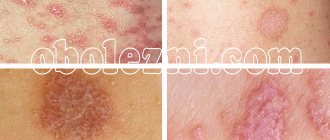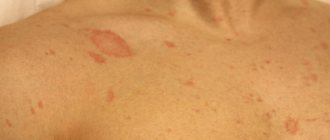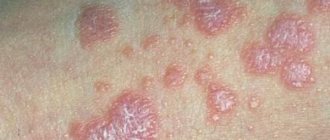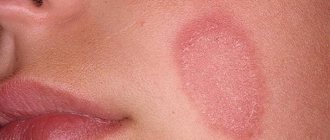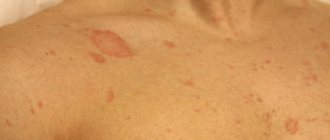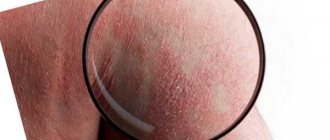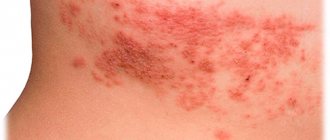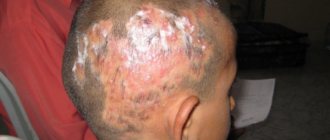Types of lichen
There are different types of feline ringworm:
- Pityriasis rosea is considered quite serious and can be recognized by small pinkish spots located all over the skin. On the skin there is a mother plaque, around which there are small daughter spots. The infected area is itchy and flaky. An interesting fact about pityriasis rosea is that the disease comes spontaneously and also goes away spontaneously.
- The ringworm infects the kitten's skin and moves from one place to another quite quickly. The cat's hair breaks off and has a trimmed appearance, resulting in baldness.
- Pityriasis appears as pink spots that disperse throughout the cat's body.
- The red flat appearance is characterized by the appearance of small blisters filled with fluid. This type becomes a chronic form of the disease and can be found not only on the body, but also in the oral cavity and on the mucous membranes.
What to do if an infection from a cat does occur?
If, after all, a child has become infected with cat lichen (or any adult), then there is no need to panic. A person is cured of lichen in 10-16 days, provided that the normal functioning of the immune system is restored. What to do? It is enough to undergo a course of treatment for this disease prescribed by a dermatologist, while simultaneously strengthening the immune system, and check your pets for the presence of ringworm.
If the animals are healthy, in this case it is recommended to vaccinate domestic cats to avoid infection with microsporia from humans. If animals are also sick, treatment and preventive measures must be applied to them.
It is more than possible to become infected with ringworm from a cat. The disease is not difficult to cure in humans and quite difficult to cure in animals. The disease belongs to the category when it is better to direct maximum efforts towards prevention than to then waste nerves, energy, money and time on treatment.
How can you get lichen
There are several ways of infection:
- Ringworm transmitted from cats can also occur from an apparently healthy pet that looks great and has no symptoms of the disease. This happens because the animal has a strong immune system, it is a carrier of this disease, is contagious to others, and does not get sick itself.
- A domestic cat that never goes outside can become infected. This happens because the owner introduces fungal spores on the shoes. The spores of the fungus that causes lichen are quite tenacious, they can be active for 2 years.
- You can become infected through contact with a sick pet. Fungal spores are easily transferred from one animal to another.
- You can also become infected through sand and soil that contain lichen spores.
- Genetic predisposition.
Persian cats are most predisposed to this disease.
Prevention
As you know, it is easier to prevent a disease than to treat it later. Preventive actions include good nutrition and caring for your pet. Timely vaccinations will help strengthen the animal's immunity. Anthelmintic measures keep cats healthy.
Daily wet cleaning helps prevent infection from fungal spores brought in with the owner's shoes. Washing with antifungal drugs will be a good preventative action for your pet.
Regular bathing and preventive examinations by a veterinarian can promptly detect disturbances in the body’s vital functions.
As you know, such an unpleasant disease as lichen usually affects pets who are deprived of care. Paying due attention to your own hygiene and attention to the cat can protect both the owner and his pet from such a nuisance as lichen, from long-term treatment and the consequences of this insidious disease.
The modern world is filled with zooanthroponotic diseases. These are diseases that are actively transmitted from animals to humans. Microsporia and trichophytosis are just such diseases - they actively spread among people, passing from mustachioed pets. That is, to the question of whether it is possible to become infected with lichen from a cat, the answer is unequivocal - yes!
Symptoms of the disease
In order to quickly treat the disease, you need to contact a veterinarian when you discover the following symptoms:
- Spots on a cat's skin that lack hair.
- The spots that appear increase in size.
- Baldness.
- Scratching the affected area of the body, most often the cat may scratch its ears.
- Symptoms such as crusts formed on bald areas of the skin will help to navigate the stage of the disease.
- Nesting baldness.
- Sick looking pet.
- The affected skin becomes keratinized.
- Sometimes symptoms such as itching may occur.
Noticing symptoms in a timely manner is the first step to preserving not only the health of the kitten, but also your own. The sooner treatment is started, the sooner recovery will occur.
Feline ringworm and humans
Feline lichen in humans is a disease that needs to be treated long and patiently. The incubation period is from a week to 3 months. As a rule, ringworm occurs in people with reduced immunity. Healthy people who follow basic hygiene rules are not at risk of ringworm, as it is easily washed off with water.
You need to wash your hands with soap not only after direct contact with cats, but also after coming from the street.
Often, lichen from a cat is transmitted to children under 15 years of age. Firstly, children have lower immunity. Secondly, as a rule, children are less likely to observe basic hygiene rules. Thirdly, they have more delicate skin, which is a “heaven” for fungus.
Prevention
It is not difficult to become infected with lichen Therefore, to prevent the disease it is necessary to carry out special prevention:
- fungal spores spread intensively in a humid environment (it is better to use special products when cleaning the room);
- after each visit to the street, wash your hands with soap;
- regularly examine the child and animal;
- Each family member should have personal hygiene products;
- take care of your health - strengthen your immune system, eat vegetables and fruits;
- do not pet stray animals;
- provide antifungal vaccination to your four-legged friend;
- If you suspect that your cat has lichen (hair loss is noticeable, bare areas of skin are visible), immediately visit a veterinarian and isolate him in another room.
Regular bathing of your animal and preventive examinations by a specialist will help to promptly recognize disorders of the body’s vital functions.
Feline lichen in humans is treated quite simply, but only at an early stage of the disease. By following all the recommendations, the pathology will disappear in 10-14 days without any negative consequences for the body.
Many people love cats and unconsciously reach out to pet a barn cat, but few people think that they may get lichen from sick cats. Feline lichen in humans is a reality, and treatment is not quick and requires a lot of effort.
Treatment of deprivation in people
Ringworm transmitted from cats is dangerous not only for the kitten, but also for people who come into contact with it. Treatment for people should be prescribed by a dermatologist. Moreover, the sooner the first symptoms are discovered after infection, the faster treatment will occur, including:
- As a rule, a dermatologist can prescribe ointments with an antifungal effect.
- At home, you can use a solution of 10 grams. elecampane roots per 100 ml. boiling water
- Treatment of lichen involves removing hair from diseased areas because it is easily transferred to healthy areas. Hair removal should be carried out for at least a week, and the head can only be washed with antifungal shampoos.
- You can treat with sulfur-salicylic ointment, which is rubbed in at night.
- Also, an area infected by a kitten can be treated by wiping with iodine.
Diagnostics
The symptoms of lichen are very diverse, some of them are characteristic of other skin diseases. Therefore, an accurate diagnosis is made using LD diagnostics (luminescent diagnostics using a Wood lamp) and laboratory tests. A Wood's lamp is an ultraviolet light source that produces almost no visible light.
Fungal lesions under its rays look like an iridescent mosaic of emerald green color. However, the reliability of luminescent diagnostics is only 60-70%. For more accurate results, laboratory tests are carried out on scrapings from the skin and animal hair samples, and the cultivation of mushrooms (growing on media) is a reliable method for diagnosing drowsiness.
Treatment for feline lichen can begin only after an appropriate diagnosis has been made. For this purpose, a Wood's lamp is used (produces long-wave ultraviolet radiation). When the scalp and other parts of the body are scanned, the affected hair glows green, which resembles the glow of phosphorus.
When exposed to a lamp, the affected areas glow green
This diagnostic method allows:
- determine the type of fungus;
- detect even a single case of infection;
- evaluate the result after the course of therapy;
- monitor the condition of the hair of people who were in constant close contact with the patient.
For a final and more reliable diagnosis, laboratory tests are required:
- Studying hair under a microscope. With feline ringworm, a mosaic arrangement of microspores is observed.
- Bac sowing. This method allows you to determine the type of fungus, so you can prescribe the optimal treatment.
Cat treatment
Treatment of a kitten should only be carried out with the advice of a veterinarian. First of all, the kitten needs to be trimmed bald, because fungal spores are transmitted from a sore spot to a healthy one instantly and sometimes it is impossible to notice a lesion that spreads further. The area affected by the fungus should be treated with iodine or alcohol (10%).
Treatment of a kitten at home should be carried out using antifungal agents. When the lesion has reached a large area of the body, antifungal drugs are used not only externally, but also internally.
If your pet experiences complications, it must be treated with antibiotics and immunostimulants.
Ringworm is recorded in weakened or pregnant cats that have helminths, which are often exposed to stress, and it is also diagnosed in kittens that do not have developed immunity.
General information on pathogen transmission
Ringworm is a spore-borne disease, which by its nature is quite tenacious and actively spreading. Spores spread into the external environment from the affected areas of the animal. Ringworm can be caused by Trichophytes or Microspores, manifesting as trichophytosis or microsporia.
It is microsporia that most often affects cats, and it is this type of lichen that poses a potential danger to humans. This is exactly the answer to the frequently asked question, what type of ringworm can be contracted from pets with a mustache (see symptoms and treatment of ringworm in cats).
How long does the lichen pathogen remain viable?
Spores of all microsporian fungi are very stable in the external environment:
- Skin scrapings can live up to 5 years.
- On wool - up to 5-7 years.
- They are resistant to freezing, drying and direct sunlight.
- However, vegetative forms of fungi (actively reproducing) die quickly under the influence of formaldehyde and alkalis.
Once on human skin, spore forms of fungi can remain in a “dormant” state for a long time until favorable conditions are created for their vegetation (germination and reproduction).
How can a person become infected?
For infection to occur, there must be direct contact with the spores. The disease spreads:
- From other animals (patients or carriers)
- In contact with objects where the sick cat was located. The easiest way to become infected with lichen is from a cat if it is a spore carrier.
For example, a person sitting on a bench in a park where a sick street cat (or a carrier) once basked in the sun will definitely bring home microsporia fungal spores on his clothes.
On the street - you need to understand that disputes can happen everywhere: parks, sandboxes, grass, dust from cars, fur from street (homeless) people or from your own pets, etc.
At home - as for pets who do not have access to the street, then humans become the source of fungal infection. He, as already noted, brings these same spores into the house on his clothes, shoes, bags, etc.
Who is most susceptible to developing shingles after infection?
The main condition is considered to be a decrease in human immunity, regardless of the reasons. That is why the following are at risk of infection:
- people of different ages with reduced immunity (severe infectious diseases, cancer patients, weakened after injuries and operations);
- pregnant women;
- children under 12-15 years old;
- people in a constant state of stress;
- people who neglect basic rules of personal hygiene.
Factors contributing to infection are:
- constant contact with cats that have access to the street;
- individual condition of a person’s skin (looseness and increased dryness of the skin, the presence of microtraumas and cracks).
